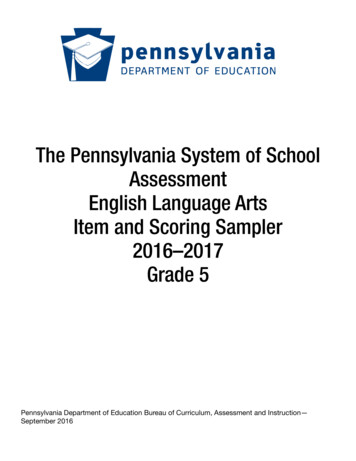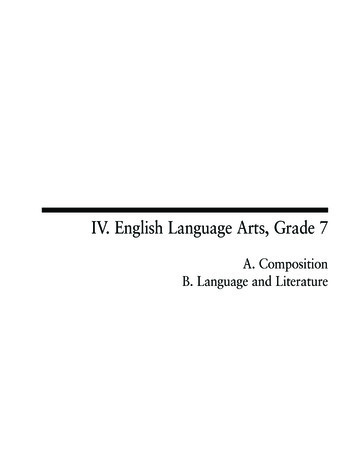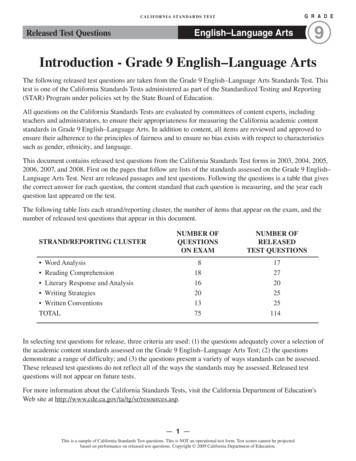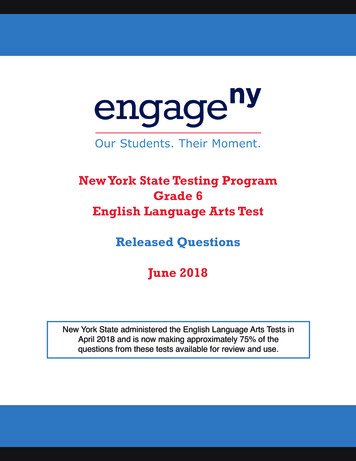
Transcription
VI. English Language Arts, Grade 7
Grade 7 English Language Arts TestThe spring 2018 grade 7 English Language Arts test was a next-generation assessment that was administered in two formats: acomputer-based version and a paper-based version. The test included both operational items, which count toward a student’s score,and matrix items. The matrix portion of the test consisted of field-test and equating questions that do not count toward a student’sscore.Most of the operational items on the grade 7 ELA test were the same, regardless of whether a student took the computer-basedversion or the paper-based version. In some instances, the wording of a paper item differed slightly from the computer-based version.In places where a technology-enhanced item was used on the computer-based test, that item was typically replaced with one or morealternative items on the paper test. These alternative items sometimes assessed the same standard as the technology-enhanced item, orother standards from the same reporting category.This document displays the paper-based versions of the 2018 operational items that have been released. The computer-basedversions of the released items are available on the MCAS Resource Center website at mcas.pearsonsupport.com/released-items.Test Sessions and Content OverviewThe grade 7 ELA test was made up of two separate test sessions. Each session included reading passages, followed by selectedresponse and essay questions. On the paper-based test, the selected-response questions were multiple-choice items, in which studentsselect the correct answer from among several answer options.Standards and Reporting CategoriesThe grade 7 ELA test was based on grades 6–12 learning standards in three content strands of the Massachusetts CurriculumFramework for English Language Arts and Literacy (2017), listed below. Reading Writing LanguageThe Massachusetts Curriculum Framework for English Language Arts and Literacy is available on the Department website atwww.doe.mass.edu/frameworks/.ELA test results are reported under three MCAS reporting categories, which are identical to the three framework content strandslisted above.The tables at the conclusion of this chapter provide the following information about each released and unreleased operational item:reporting category, standard(s) covered, item type, and item description. The correct answers for released selected-response questionsare also displayed in the released item table.Reference MaterialsDuring both ELA test sessions, the use of bilingual word-to-word dictionaries was allowed for current and former English learnerstudents only. No other reference materials were allowed during any ELA test session.89
Grade 7 English Language ArtsThis session contains 10 questions.DirectionsRead each passage and question carefully. Then answer each question as well as youcan. You must record all answers in your Student Answer Booklet.For most questions, you will mark your answers by filling in the circles in your StudentAnswer Booklet. Make sure you darken the circles completely. Do not make any marksoutside of the circles. If you need to change an answer, be sure to erase your firstanswer completely.Some questions will ask you to write a response. Write each response in the spaceprovided in your Student Answer Booklet. Only responses written within the providedspace will be scored.90
English Language Arts In the first half of the 1800s, many girls between the ages of 10 and 14 weresent by their families to work in the large mills in Lowell, Massachusetts. Readthe historical article and a passage from a novel about this experience, andthen answer the questions that follow.The article “Lucy Larcom and Harriet Hanson: Voices of the Mills” describes the truestory of two girls who worked in the mills.Lucy Larcom and Harriet Hanson: Voices of the MillsLowell, Massachusetts, 1830sby Phillip Hoose“Why it is nothing but fun. Itis just like play.”—Lucy Larcom to her familyafter her first day of work1 Textile mills sprang up along rivers throughout New England, their noisyrooms filled with girls and young women from New England farms. Theywere hardworking girls who left home to help their families and to findadventure in the city. A mill girl arrived in a factory town clutching a singlecarpetbag or “hair trunk” and walked down treeless streets lined with brickboardinghouses that all looked alike, searching for the address that hadbeen written on a scrap of paper. Upon arrival she would check in with themistress, throw her bag on a bed, introduce herself to six or eight newroommates, and try to get some sleep. She would need it.91
English Language Arts 2 Lucy Larcom was eleven when she and her older sister Linda first walkedthrough the gates of the giant mill at Lowell, Massachusetts. Lucy hadagreed to apply for a job because she felt guilty that she was anothermouth for her mother to feed. Lucy’s mother ran a boardinghouse for millgirls and women, but there was never enough money. The mill agent hadonly one job. He offered it to Lucy because she was taller than Linda andhe thought that meant she was older. Both girls kept their mouths shut.3 Lucy’s aunt had taught her to read and she loved the time she had spentin school. Still, even as a little child, she always expected that she’d windup in the mill. “As a small child I got the idea that the chief end of womanwas to make clothing for mankind,” she later wrote. “I supposed I’d haveto grow up and have a husband and put all those little stitches in his coatsand pantaloons.”4 But, for the sake of the family, Lucy put aside her dreams and took a jobas a “bobbin girl” in the spinning room. The windows were nailed shutand the room was hot and damp. Her wage was a dollar a week. Still,she made up her mind to be happy. “I went to my first day’s work in themill with a light heart,” she wrote. “And it really was not so hard, just tochange the bobbins1 on the spinning frames2 every three-quarters of anhour or so, with half a dozen other girls who were doing the same thing.”5 But after a while the fun wore off. Each day started at five in the morningwith a bone-rattling blast from the factory whistle. There was barely enoughtime to splash cold water on her face, stuff breakfast in one pocket andlunch in another, and sprint to the spinning room on the second floor ofthe mill. Like the others, Lucy pinned her hair up to make sure it didn’t getcaught in the wheels. Then she faced her machine, reminding herself to becareful about where she put her fingers.6 As the days wore on, Lucy pasted poems on the nearest window and triedto will the noise away. “I defied the machinery to make me its slave,” shewrote. “Its incessant discourds3 could not drown the music of my thoughtsif I would let them fly high enough.” But sometimes it was hard to makethoughts fly so high. “The buzzing and hissing whizzing of pulleys androllers and spindles and flyers often grew tiresome. I could not see intotheir complications or feel interested in them . . . When you do the samething twenty times—a hundred times a day—it is so dull !”1bobbins—spoolsthat hold yarn for sewing or weavingframes—machines that twist fibers into yarn3discourds—unpleasant noises2spinning92
English Language Arts 7 Lowell mill girls got a fifteen-minute breakfast break and another thirtyminutes for lunch at noon. Most stood all day. The little ones often fellasleep standing up. But the machines never slept. Mill owners convincedthemselves that they were helping children build character through hardwork. They fired men and replaced them with women and children, whoworked for lower wages. Soon whole families began to live off the wages oftheir exhausted children.8 In the 1830s, the mill women and girls began to stand up for themselves,organizing strikes for more pay and shorter hours. Eleven-year-old HarrietHanson, also the daughter of a rooming-house keeper, was one of fifteenhundred girls who walked out of the Lowell mill in 1836. They wereprotesting the company’s plan to raise the fees the workers had to payto sleep in a company-owned boardinghouse like the one run by Harriet’smother.9 Because the company controlled virtually every part of a mill girl’s life,it took a lot of courage to even think about “turning out,” as they calledstriking. For weeks, Harriet listened as girls and women on her floordiscussed just that, and then, finally, made up their minds to walk out. Whenthe strike day came and the signal to stop working was passed around,so many workers on the upper floors spilled out chanting into the streetthat the entire mill was shut down. But the girls in Harriet’s spinning roomremained frozen in place, glancing nervously at one another and wonderingwhat to do. What if they lost their jobs? What would the company do tothem?10 Harriet was disgusted. After all their talk about oppression,4 how could theyeven think about staying inside? For long minutes they stood indecisively attheir looms, whispering among themselves. Finally Harriet faced them.“I don’t care what you do,” she said firmly. “I am going to turn outwhether anyone else does or not.”11 With that, Harriet marched toward the door, eyes straight ahead. In thenext moment she heard a great shuffling of feet. She looked back tosee the entire floor lining up behind her. Everyone was turning out. Asexpected, the company punished Harriet by taking the boardinghouse awayfrom her mother. “Mrs. Hanson,” the agent lectured, “you could not preventthe older girls among your boarders from turning out, but your daughter isa child, and her you could control.”4oppression—asituation in which a group of people are unfairly forced to do something93
English Language Arts 12 Harriet never regretted what she did. Many years later she said that leadingthat walkout was the best moment of her life. “As I looked back on the longline that followed me,” she later wrote, “I was more proud than I have everbeen since.”WHAT HAPPENED TO LUCY LARCOM AND HARRIET HANSON?13 Lucy left Lowell and went west with her sister and brother-in-law. Shenever stitched a husband’s pantaloons, choosing a life of teaching andwriting over marriage. She became a well-known writer and poet. Harrietcontinued to lead and to fight. She eventually married a newspaper editor,and together they worked to convince people to oppose slavery. In 1882,Harriet became one of the first women to testify before Congress in favorof the right of women to vote.“Lucy Larcom and Harriet Hanson: Voices of the Mills” by Phillip Hoose, from We Were There Too!: Young Peoplein U.S. History. Text copyright 2001 by Phillip Hoose. Reprinted by permission of Farrar, Straus and Giroux, LLC.Photograph courtesy of the Library of Congress.94
English Language Arts In the passage from the novel Lyddie, Lyddie and Diana are two girls who work in themills in Lowell. They live away from their families in a boardinghouse run by Mrs. Bedlow.from Lyddieby Katherine Paterson1 The four-thirty bell clanged the house awake. From every direction, Lyddiecould hear the shrill voices of girls calling to one another, even singing.Someone on another floor was imitating a rooster. From the other side of thebed Betsy groaned and turned over, but Lyddie was up, dressing quickly in thedark as she had always done in the windowless attic of the inn.2 Her stomach rumbled, but she ignored it. There would be no breakfast untilseven, and that was two and a half hours away. By five the girls had crowdedthrough the main gate, jostled their way up the outside staircase on the farend of the mill, cleaned their machines, and stood waiting for the workday tobegin.3 “Not too tired this morning?” Diana asked by way of greeting.4 Lyddie shook her head. Her feet were sore, but she’d felt tireder after a daybehind the plow.5 “Good. Today will be something more strenuous, I fear. We’ll work all threelooms together, all right? Until you feel quite sure of everything.”6 Lyddie felt a bit as though the older girl were whispering in church. It seemedalmost that quiet in the great loom room. The only real noise was thecreaking from the ceiling of the leather belts that connected the wheels in theweaving room to the gigantic waterwheel in the basement.7 The overseer came in, nodded good morning, and pushed a low woodenstool under a cord dangling from the assembly of wheels and belts above hishead. His little red mouth pursed, he stepped up on the stool and pulled outhis pocket watch. At the same moment, the bell in the tower above the roofbegan to ring. He yanked the cord, the wide leather belt above him shiftedfrom a loose to a tight pulley, and suddenly all the hundred or so silentlooms, in raucous concert, shuddered and groaned into fearsome life. Lyddie’sfirst full day as a factory girl had begun.8 Within five minutes, her head felt like a log being split to splinters. She keptshaking it, as though she could rid it of the noise, or at least the pain, butboth only seemed to grow more intense. If that weren’t trial enough, a fewhours of standing in her proud new boots and her feet had swollen so thatthe laces cut into her flesh. She bent down quickly to loosen them, and whenshe found the right lace was knotted, she nearly burst into tears. Or perhapsthe tears were caused by the swirling dust and lint.95
English Language Arts 9 Now that she thought of it, she could hardly breathe, the air was so ladenwith moisture and debris. She snatched a moment to run to the window. Shehad to get air, but the window was nailed shut against the April morning. Sheleaned her forehead against it; even the glass seemed hot. Her apron brushedthe pots of red geraniums crowding the wide sill. They were flourishing in thishot house. She coughed, trying to free her throat and lungs for breath.10 Then she felt, rather than saw, Diana. “Mr. Marsden has his eye on you,” theolder girl said gently, and put her arm on Lyddie’s shoulder to turn her backtoward the looms. She pointed to the stalled loom and the broken warp threadthat must be tied. Even though Diana had stopped the loom, Lyddie stoodrubbing the powder into her fingertips, hesitating to plunge her hands into thebowels of the machine. Diana urged her with a light touch.11 I stared down a black bear, Lyddie reminded herself. She took a deep breath,fished out the broken ends, and began to tie the weaver’s knot that Diana hadshown her over and over again the afternoon before. Finally, Lyddie managedto make a clumsy knot, and Diana pulled the lever, and the loom shudderedto life once more.12 How could she ever get accustomed to this inferno? Even when the girls wereset free at 7:00, it was to push and shove their way across the bridge anddown the street to their boardinghouses, bolt down their hearty breakfast,and rush back, stomachs still churning, for “ring in” at 7:35. Nearly half themealtime was spent simply going up and down the staircase, across the millyard and bridge, down the row of houses—just getting to and from the meal.And the din in the dining room was nearly as loud as the racket in the mill—thirty young women chewing and calling at the same time, reaching for theplatters of flapjacks and pitchers of syrup, ignoring cries from the other end ofthe table to pass anything.13 Her quiet meals in the corner of the kitchen with Triphena, even her meagerbowls of bark soup in the cabin with the seldom talkative Charlie, seemed likefeasts compared to the huge, rushed, noisy affairs in Mrs. Bedlow’s house. Thehalf hour at noonday dinner with more food than she had ever had set beforeher at one time was worse than breakfast.14 At last the evening bell rang, and Mr. Marsden pulled the cord to end the day.Diana walked with her to the place by the door where the girls hung theirbonnets and shawls, and handed Lyddie hers. “Let’s forget about studyingthose regulations tonight,” she said. “It’s been too long a day already.”15 Lyddie nodded. Yesterday seemed years in the past. She couldn’t evenremember why she’d thought the regulations important enough to bother with.Lyddie by Katherine Paterson. Copyright 1991 by Katherine Paterson. Reprinted by permission of Dutton Children’sBooks, an imprint of Penguin Young Readers Group, a division of Penguin Random House LLC.96
English Language Arts aWhat is the most likely reason the author included paragraph 1 of “LucyLarcom and Harriet Hanson”?A. to illustrate that many mill workers came from selfish familiesB. to demonstrate that many mill workers had negative attitudesC. to emphasize that many mill workers had similar experiencesD. to highlight that many mill workers lived with supportive roommatessWhich sentence from “Lucy Larcom and Harriet Hanson” best shows Lucy’sunwillingness to give in to the difficulties of life in the mill?A. “Still, even as a little child, she always expected that she’d wind up in themill.” (paragraph 3)B. “But, for the sake of the family, Lucy put aside her dreams. . . .” (paragraph 4)C. “‘I defied the machinery to make me its slave,’ . . .” (paragraph 6)D. “‘The buzzing and hissing whizzing of pulleys and rollers and spindles andflyers often grew tiresome.’” (paragraph 6)97
English Language Arts d Read the sentences from paragraph 7 of “Lucy Larcom and Harriet Hanson” inthe box.The little ones often fell asleep standing up. But the machines never slept.What is the main effect of the author’s use of personification?A. It suggests competition between the child workers and the machines.B. It emphasizes a contrast between the child workers and the machines.C. It demonstrates the advantages that the child workers had over themachines.D. It shows that child workers were important to the proper functioning of themachines.fIn “Lucy Larcom and Harriet Hanson,” why did the company take theboardinghouse away from Harriet’s mother?A. Harriet had not paid a fine to the agent.B. Harriet’s mother had not let Harriet complete her work.C. Harriet had not allowed the older girls to leave for the day.D. Harriet’s mother had not stopped Harriet from taking action.98
English Language Arts gBased on “Lucy Larcom and Harriet Hanson,” how was Harriet’s life mostlyaffected by her actions?A. She was fired by the mill owners.B. She decided to fight for equality for others.C. She was determined to demand more money in future jobs.D. She was motivated by her experience to start her own business.hPart AWhat does the word trial mean as it is used in paragraph 8 of Lyddie?A. a scientific testB. a court processC. a serious challengeD. a surprising changePart BWhich phrase from paragraph 8 best supports the answer to Part A?A. “Within five minutes . . .”B. “. . . her head felt like a log being split. . . .”C. “. . . proud new boots . . .”D. “She bent down quickly. . . .”99
English Language Arts j Read the description from paragraph 9 of Lyddie in the box.Now that she thought of it, she could hardly breathe, the air was so ladenwith moisture and debris. She snatched a moment to run to the window.She had to get air, but the window was nailed shut against the Aprilmorning. She leaned her forehead against it; even the glass seemed hot.What is the main purpose of the description?A. to reveal an important themeB. to foreshadow a future eventC. to illustrate how a character resolves a conflictD. to show the impact of the setting on a characterk Read the sentence from paragraph 15 of Lyddie in the box.Yesterday seemed years in the past.Based on the passage, what does the sentence mainly suggest about Lyddie?A. She is impressed by the machinery at the mill.B. She realizes her life has changed significantly.C. She misses her family more than she expected.D. She is unable to remember working on the farm.100
English Language Arts lPart AWhat does the author of “Lucy Larcom and Harriet Hanson” mainly suggestabout working in the mills?A. It taught the workers to be dependable.B. It was a miserable experience for the workers.C. It was an easy way for the workers to earn money.D. It helped the workers learn skills they could use on their farms.Part BWhich sentence from Lyddie best supports the answer to Part A?A. “From every direction, Lyddie could hear the shrill voices of girls calling toone another, even singing.” (paragraph 1)B. “Lyddie’s first full day as a factory girl had begun.” (paragraph 7)C. “Or perhaps the tears were caused by the swirling dust and lint.” (paragraph 8)D. “She pointed to the stalled loom and the broken warp thread that must betied.” (paragraph 10)101
English Language Arts For this question, you will write an essay based on the passage(s). Write youressay in the space provided in your Student Answer Booklet. Your writingshould:; Present and develop a central idea. Provide evidence and/or details from the passage(s). Use correct grammar, spelling, and punctuation.Write an essay identifying a central idea of both “Lucy Larcom and HarrietHanson” and Lyddie, and explain how it is developed throughout each text. Besure to use information from both the article and the passage to develop youressay.102
Grade 7 English Language ArtsSpring 2018 Released Operational Items:Reporting Categories, Standards, Item Descriptions, and Correct y the purpose of the first paragraph ofan article.C1197ReadingRI.7.2SRIdentify evidence from an article to support agiven trait of a historical figure.C1298ReadingRI.7.4SRAnalyze the effect of a specific use offigurative language in an article.B1398ReadingRI.7.3SRAnalyze why an event happens in the life of ahistorical figure in an article.D1499ReadingRI.7.3SRDetermine the effects of a historical figure’sactions in an article.BL.7.4SRUse context to determine the correct meaningof a word with multiple definitions; selectevidence from provided details from thepassage to support the adingRL.7.5SRAnalyze the purpose of descriptive sentencesin a passage.D17100ReadingRL.7.1SRMake an inference about a character in apassage.B18101ReadingRI.7.8SRAnalyze the argument of an article; identifyevidence from details provided from a relatedliterary passage to support analysis.ESWrite an essay identifying and analyzing thedevelopment of a main idea in an article andpassage on the same topic; cite evidence fromboth the article and the passage to support theessay.19102Language, WritingL.7.1, L.7.2, L.7.3,W.7.2, W.7.4B;C* “PBT Item Number” refers to the position of the item on the operational paper-based test. This is the item number that DESE refers to whenreporting student results for a PBT item.** ELA item types are: selected-response (SR), constructed-response (CR), and essay (ES).*** Answers are provided here for selected-response items only. Sample responses and scoring guidelines for any constructed-response and essayitems will be posted to the Department’s website later this year.103
Grade 7 English Language ArtsSpring 2018 Unreleased Operational Items:Reporting Categories, Standards, and Item emType**Description1ReadingRL.7.5SRAnalyze how specific paragraphs in a passage establish an importantcontrast.2ReadingRL.7.2SRMake an inference about the relationship between characters in a passage.3ReadingRL.7.6SRAnalyze how details in an internal monologue help readers understanda character in a passage; select evidence from provided details from thepassage to support the analysis.4ReadingRL.7.3SRMake an inference about a character based on his actions in a passage.5ReadingRL.7.6SRAnalyze a narrator’s use of figurative language in a passage to determineher point of view on a topic.6ReadingRL.7.6SRAnalyze how a line of dialogue from a passage develops a character’s pointof view.7ReadingRL.7.5SRAnalyze how specific paragraphs contribute to the meaning of a passage.8LanguageL.7.4SRUse context to determine the meaning of a word.9Language, WritingL.7.1, L.7.2,L.7.3, W.7.3,W.7.4ESWrite a narrative that continues the story from the point of view of acharacter other than the narrator; use details from the passage to supportthe narrative.20ReadingRL.7.1SRMake an inference about a character in a passage from evidence in aninternal monologue.21ReadingRL.7.2SRDetermine how specific sentences contribute to the central idea of apassage.22ReadingRL.7.6SRAnalyze how specific sentences from a passage reveal a character’s point ofview.23LanguageL.7.5SRUse context to determine the connotation of a word with multiple meaningsin a passage.24ReadingRL.7.1SRMake an inference about how characters from two different passages aresimilar.25ReadingRL.7.6SRDetermine how the points of view of characters in two different passagesare similar.26ReadingRL.7.2SRIdentify a common theme of two passages.27Language, WritingL.7.1, L.7.2,L.7.3, W.7.2,W.7.4ESWrite an essay that analyzes the effect that one character has on two othercharacters in different passages from the same source; cite evidence fromboth passages and explain how it supports the essay.* “PBT Item Number” refers to the position of the item on the operational paper-based test. This is the item number that DESE refers to whenreporting student results for a PBT item.** ELA item types are: selected-response (SR), constructed-response (CR), and essay (ES).104
as a "bobbin girl" in the spinning room. The windows were nailed shut and the room was hot and damp. Her wage was a dollar a week. Still, she made up her mind to be happy. "I went to my first day's work in the mill with a light heart," she wrote. "And it really was not so hard, just to change the bobbins. 1. on the spinning frames. 2











